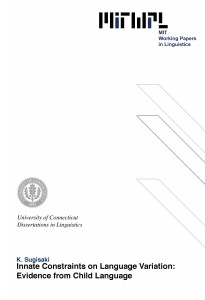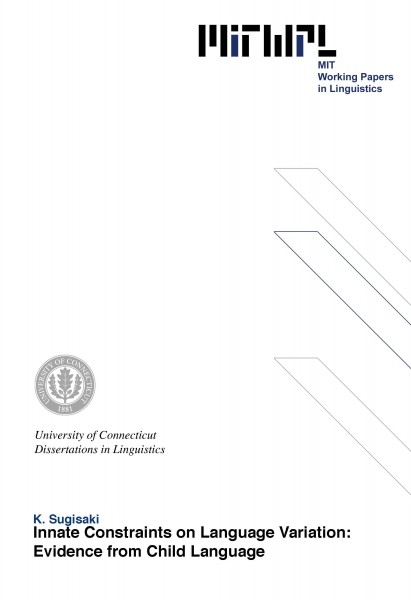Innate Constraints on Language Variation: Evidence from Child Language
K. Sugisaki, 2003
Within the Principles and Parameters approach to Universal Grammar (Chomsky 1981), language acquisition is assumed to be the process of setting the values of parameters, which are conceived of as innately-specified points of grammatical variation that have multiple consequences for the surface grammar. Given this view, it is expected that parameter-setting, more accurately the time required to accommodate the data indicating the correct parameter-settings plays an important role to explain why language acquisition is not ‘instantaneous’ and proceeds gradually. Yet, despite this expectation, few pieces of clear evidence have been provided for parameter-setting from child language acquisition. This situation has led to the recent, influential hypothesis by Wexler (1996, 1998), which claims that basic parameters are set correctly at the earliest observable stages (Very Early Parameter-Setting, VEPS).
In this thesis, I will present evidence against the “strongest” form of VEPS, the hypothesis that all the parameters are set to the adult value at the earliest stages. The evidence comes from the acquisition of three syntactic properties: preposition stranding, scrambling, and resultatives. A strong acquisitional association has been found (i) between preposition stranding and the prepositional complementizer construction, (ii) between the multiple-nominative construction and Japanese-type scrambling, and (iii) between noun compounding and transitive resultatives. These results not only argue for the existence of the relevant parameters, but also constitute a clear indication that parameter-setting in fact plays a significant role in explaining the non-instantaneous and gradual nature of language acquisition. These findings in turn demonstrate that the time course of child language acquisition is a rich source of evidence concerning the innate constraints on language variation.
Chapter 1 Introduction 1
1.1 Goal 1
1.2 Logical Problem of Language Acquisition 2
1.3 Universal Grammar 5
1.4 Early Emergence of UG Principles 8
1.5 Identifying the Developmental Factors 10
1.5.1 Parameter Setting 11
1.5.2 Maturation 14
1.5.3 Delayed Development of Pragmatic Knowledge 16
1.6 Very Early Parameter-Setting 19
1.7 Outline of the Dissertation 23
Chapter 2 Preposition Stranding and Parameters 25
2.1 Introduction 25
2.2 Kayne’s (1981, 1984) Parameter of Prepositional Case 29
2.3 Predictions for Cross-linguistic Variation and Acquisition 36
2.4 Transcript Analysis I: Preposition Stranding and Double
Accusatives 42
2.4.1 Subjects and Methods 42
2.4.2 Results and Discussion 44
2.5 Transcript Analysis II: Preposition Stranding and the Prepositional
Complementizer Construction 48
2.5.1 Subjects and Methods 48
2.5.2 Results and Discussion 48
2.6 Discussion 51
2.7. On the Nature of the Preposition-Stranding Parameter 53
2.8. Conclusion 60
Appendix to Chapter 2: Children’s First Clear Use 62
Chapter 3 Scrambling and Parameters 64
3.1 Introduction 64
3.2 Deriving the MNC and Scrambling 67
3.2.1 Fukui (1986): Defective INFL in Japanese 67
3.2.2 Kuroda (1988): Forced Agreement Parameter 72
3.2.3 Problems of Fukui (1986) and Kuroda (1988) 76
3.2.4 Grewendorf & Sabel (1999): Projection of Multiple
Specifiers 78
3.3 Evaluating Predictions for Cross-linguistic Variation from
Grewendorf & Sabel (1999) 86
3.4 Predictions for Acquisition from Grewendorf & Sabel (1999) 93
3.5 Experiment 94
3.5.1 Subjects 94
3.5.2 Methods 95
3.5.3 Results 100
3.5.4 Discussion 101
3.6 Conclusion 105
Appendix I to Chapter 3: Scrambling and the MNC Cross-linguistically 107
Appendix II to Chapter 3: Test Items and Individual Responses 118
Chapter 4 Resultatives and Parameters 124
4.1 Introduction 124
4.2 The Theory of Compounding Parameter 125
4.3 A Remaining Issue: Acquisition of Resultatives 130
4.4 Logic of the Experiment 134
4.5 Experiment 135
4.5.1 Subjects 135
4.5.2 Methods 135
4.5.3 A Note on Methodology 141
4.5.4 Results 142
4.5.5 Discussion 144
4.6 Conclusion 147
Appendix to Chapter 4: Individual Responses 148
Chapter 5 Concluding Remarks 151
References 156

